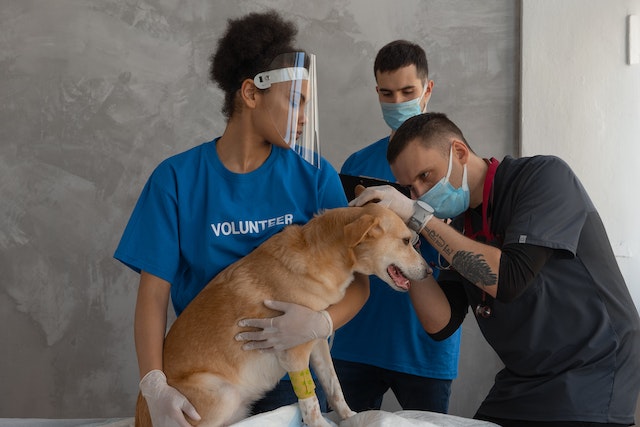11 Common Dog Ear Problems With Tips

Hey there, fellow dog lovers! We all know that our furry friends rely on us to keep them happy and healthy.
Today, I want to talk about a common issue that can cause discomfort for our dogs – ear problems.
So, grab your coffee, and let’s dive into some tips and tricks to keep those precious ears wagging!
Let’s get started…
Common Signs of Dog Ear Problems
Ear problems are a common issue in dogs and can be caused by various factors such as allergies, infections, foreign bodies, or ear mites.
It’s important for dog owners to be aware of the signs that may indicate an ear problem in their furry friends.
Here are some of the most common signs to watch out for:
- Ear Scratching: If you notice your dog frequently scratching or pawing at their ears, it could be a sign of an ear problem. Dogs may scratch their ears when they feel itchiness or discomfort.
- Head Shaking: Excessive head shaking is another sign that your dog may be experiencing ear trouble. They may vigorously shake their head from side to side in an attempt to relieve the discomfort.
- Ear Odor: A foul smell emanating from your dog’s ears can indicate an infection or an accumulation of wax and debris. If you notice an unusual odor, it’s worth investigating further.
- Redness and Swelling: Inflamed or swollen ear tissue, along with redness, can be a sign of an underlying ear problem. This can occur due to allergies, infections, or other irritants.
- Discharge: Unusual discharge from the ears, such as pus or a brown, waxy substance, may indicate an infection or infestation. The discharge may be accompanied by other symptoms like redness or foul odor.
- Ear Sensitivity: Dogs with ear problems may exhibit sensitivity when their ears are touched or manipulated. They might pull away, whimper, or show signs of discomfort when you try to examine their ears.
- Tilting of the Head: If you notice your dog tilting their head to one side or holding it at an unusual angle, it can be a sign of an ear problem. This could indicate an infection or an issue with their balance.
- Loss of Balance: Ear problems can affect a dog’s balance and coordination. If you observe your dog stumbling, falling, or having difficulty walking, it could be related to an ear issue.
- Behavioral Changes: Dogs in pain or discomfort may exhibit changes in behavior. They might become more irritable, restless, or lethargic. If you notice any unusual behavioral changes, it’s worth considering if an ear problem could be the cause.
It’s important to note that these signs can vary depending on the specific ear problem your dog is experiencing.
If you notice any of these signs or suspect an ear problem, it’s best to consult with a veterinarian for a proper diagnosis and appropriate treatment.
Common Dog Ear Problems
The following are some of the most common dog ear problems:
1. Bacterial Ear Infections
Bacterial ear infections are a common problem in dogs, often caused by an overgrowth of bacteria in the ear canal. The most common causes include moisture buildup, allergies, or foreign objects in the ear.
To prevent bacterial ear infections, it’s important to keep your dog’s ears clean and dry, especially after swimming or bathing. Regular ear checks and proper grooming can help identify any potential issues early on.
Treatment usually involves cleaning the ear canal and administering antibiotics prescribed by a veterinarian. In severe cases, surgery may be required to address underlying causes.
2. Yeast Ear Infections
Yeast ear infections are a common dog ear problem caused by the overgrowth of yeast organisms in the ear canal.
The primary cause of yeast ear infections in dogs is excessive moisture in the ear, which creates an ideal environment for yeast to thrive.
Prevention involves regular ear cleaning and drying, especially after swimming or bathing. Treatment typically includes ear cleaning with a veterinarian-recommended solution and the use of antifungal medications.
In severe cases, oral antifungal medications may be prescribed. Regular veterinarian check-ups can help detect and address yeast ear infections early.
3. Ear Mites (Otodectes Cynotis)
Ear mites, scientifically known as Otodectes cynotis, are a common problem in dogs. They are tiny parasites that live in the ear canal and feed on skin debris and ear wax.
Ear mites in dogs are highly contagious and can easily transmit from one dog to another through direct contact.
Prevention involves regular ear cleaning and maintaining good hygiene for your dog.
Treatment typically involves medicated ear drops or ointments prescribed by a veterinarian. In severe cases, oral medications may also be necessary.
4. Allergies
Allergies in dogs can commonly lead to ear problems. These allergies can be caused by various factors, including environmental allergens like pollen, dust mites, or mold, as well as food allergies.
Prevention includes minimizing exposure to known allergens and maintaining good hygiene, such as regular ear cleaning and grooming.
Treatment options may include antihistamines or corticosteroids to manage symptoms, as well as a hypoallergenic diet for dogs with food allergies.
In severe cases, a veterinarian may recommend allergy testing and desensitization therapy.
5. Ear Hematomas
Ear hematomas in dogs are a common ear problem that occurs when blood accumulates between the skin and cartilage of the ear flap.
The most common cause of ear hematomas is excessive shaking or scratching of the ears due to ear infections, allergies, or ear mites.
Prevention can be achieved by regularly cleaning and inspecting the dog’s ears, addressing any underlying ear issues promptly, and providing proper ear care.
Treatment typically involves draining the accumulated blood through surgical or non-surgical methods, followed by addressing the underlying cause and providing appropriate medication or treatment for the ear condition.
Early detection and prompt treatment are crucial to prevent complications and ensure a successful recovery.
6. Ear Polyps and Tumors
Ear polyps and tumors are common ear problems in dogs. They can be caused by chronic ear infections, allergies, or genetic predisposition.
Prevention involves regular ear cleaning and prompt treatment of any ear infections.
Treatment options may include surgical removal of the polyps or tumors, medication to reduce inflammation and infection, and follow-up care to prevent recurrence.
Consulting with a veterinarian is crucial for accurate diagnosis and appropriate treatment of ear polyps and tumors in dogs.
7. Ear Wax Buildup
Ear wax buildup in dogs is a common ear problem that can cause discomfort and even lead to infections.
The primary causes of ear wax buildup in dogs include excessive production of ear wax, inadequate ear cleaning, and certain underlying health conditions.
To prevent ear wax buildup, regular ear cleaning using veterinarian-recommended products is essential.
Treatment for ear wax buildup may involve cleaning the ears with a gentle ear cleanser and removing the excess wax with the help of a veterinarian.
It is important to seek veterinary advice to determine the underlying cause and ensure appropriate treatment for the dog’s specific condition.
8. Ear Canal Blockage
Ear canal blockage is a common problem in dogs, often caused by excessive wax buildup, foreign objects, or ear infections.
Prevention can be achieved by regular cleaning and inspection of the ears, especially in breeds prone to ear problems.
Treatment typically involves cleaning the ears with a veterinarian-recommended solution, removing any foreign objects, and administering appropriate medication for underlying infections.
In severe cases, surgery may be necessary to remove blockages. Regular ear care and prompt veterinary attention can help prevent and manage ear canal blockages in dogs.
9. Ear Cancer
Ear cancer in dogs is a rare but serious condition that affects the ear canal or the surrounding tissues.
The causes of ear cancer in dogs are not well understood, but factors such as chronic inflammation, exposure to certain chemicals, and genetic predisposition may play a role.
Prevention of ear cancer in dogs involves regular ear cleaning and inspection, prompt treatment of any ear infections or injuries, and minimizing exposure to potential carcinogens.
Treatment options for ear cancer in dogs may include surgery to remove the tumor, radiation therapy, and chemotherapy.
Early detection and intervention are crucial for the successful management of ear cancer in dogs.
10. Deafness
Deafness in dogs is a relatively common ear problem that can affect their quality of life. It can be caused by a variety of factors, including genetics, age-related degeneration, and exposure to loud noises.
Prevention of deafness in dogs may involve avoiding excessive noise exposure and practicing responsible breeding. Unfortunately, there is no cure for deafness in dogs.
However, certain management techniques, such as hand signals and training, can help deaf dogs adapt and communicate effectively with their owners.
Regular veterinary check-ups and early detection of deafness can also aid in providing appropriate care and support for deaf dogs.
11. Ear Trauma
Ear trauma in dogs is a common dog ear problem that can be caused by various factors. The most common causes of ear trauma in dogs include excessive scratching, ear infections, foreign objects stuck in the ear, and rough play with other dogs.
Prevention of ear trauma involves regular ear cleaning, avoiding excessive scratching, and providing a safe environment for the dog.
Treatment of ear trauma in dogs typically involves cleaning the ear and administering appropriate medication such as antibiotics or anti-inflammatory drugs, and in severe cases, surgical intervention may be required.
It is important to consult a veterinarian for proper diagnosis and treatment of ear trauma in dogs.
Diagnosis of Ear Problems in Dogs
Diagnosing ear problems in dogs typically involves a thorough physical examination of the ears, including visual inspection and palpation.
A veterinarian may use an otoscope to examine the ear canal and check for signs of infection, inflammation, or abnormalities.
They may also collect a sample of ear discharge for laboratory analysis to identify the specific cause of the problem, such as bacteria or yeast.
In some cases, additional diagnostic tests like ear cytology or culture and sensitivity testing may be recommended.
The diagnosis of ear problems in dogs relies on a comprehensive evaluation to determine the underlying cause and guide appropriate treatment.
Read more about dog health problems.
Treatment Options for Dog Ear Problems
To treat ear problems in dogs, it is important to identify the underlying cause of the issue. Here are some steps you can take to treat ear problems in dogs:
Step 1: Recognize the signs of ear problems
Common signs of ear problems in dogs include:
- Scratching or rubbing their ears
- Head shaking or tilting
- Redness or swelling in the ear
- Discharge or odor from the ear
- Pain or discomfort when touching the ear
Step 2: Consult with a veterinarian
If you suspect your dog has an ear problem, it is important to consult with a veterinarian for a proper diagnosis. They will be able to determine the cause of the issue and recommend the appropriate treatment.
Step 3: Cleaning the ears
Cleaning the ears is an important part of treating ear problems in dogs. Your veterinarian may provide you with a medicated ear cleaner to use at home. Follow their instructions carefully and gently clean your dog’s ears to remove debris, discharge, and ear wax.
Step 4: Medication
Depending on the cause and severity of the ear problem, your veterinarian may prescribe medication for your dog. This can include:
- Antibiotics: If the ear problem is caused by a bacterial infection, antibiotics may be prescribed to help clear the infection.
- Antifungals: In the case of a fungal infection, antifungal medications may be recommended.
- Anti-inflammatory drugs: These can help reduce inflammation and relieve pain in the ears.
Step 5: Follow-up care
It is important to follow your veterinarian’s instructions for follow-up care. This may include continuing with medication, scheduling follow-up appointments, or monitoring your dog’s progress.
Be sure to reach out to your veterinarian if you have any concerns or if your dog’s condition worsens.
Preventing Ear Problems in Dog
Here are some common ways to prevent ear problems in dogs:
1. Regular Cleaning: Regularly cleaning your dog’s ears can help prevent the buildup of dirt, debris, and wax that can lead to infections. Use a gentle ear-cleaning solution recommended by your veterinarian and follow the instructions for proper cleaning techniques.
2. Proper Grooming: Keeping your dog’s ears properly groomed can help prevent ear problems. Trim excess hair around the ears to allow for better air circulation and reduce the risk of moisture buildup.
3. Dry Ears After Bathing or Swimming: Moisture in the ear can create an ideal environment for bacteria and yeast to thrive. After bathing or swimming, make sure to thoroughly dry your dog’s ears using a clean towel or a gentle ear-drying solution.
4. Allergen Management: If your dog has allergies, it’s important to identify and manage the allergens that can trigger ear problems. This may involve avoiding certain foods, or environmental allergens, or using allergy medications as prescribed by your veterinarian.
5. Regular Veterinary Check-ups: Regular check-ups with your veterinarian can help detect early signs of potential ear problems in your dog. Your veterinarian can examine your dog’s ears, clean them if necessary, and provide appropriate preventive measures.
6. Avoid Irritants: Avoid exposing your dog’s ears to irritants such as cigarette smoke, strong perfumes, cleaning chemicals, or other substances that can cause inflammation or irritation.
7. Prevent Ear Infections: Ear infections can be a common issue in dogs. Preventative measures include regular cleaning, avoiding excessive moisture in the ears, and addressing any underlying health conditions that may contribute to infections.
8. Avoid Over-cleaning: While regular cleaning is important, over-cleaning can disrupt the natural balance of the ear and potentially cause irritation. Follow your veterinarian’s recommendations for the frequency of ear cleaning.
9. Regular Flea and Tick Prevention: Fleas and ticks can cause irritation and lead to ear problems in dogs. Use appropriate flea and tick prevention methods recommended by your veterinarian to keep your dog protected.
Frequently Asked Questions
Can dogs get ear infections from swimming?
Yes, dogs can get ear infections from swimming, especially if water gets trapped in the ear canal. It creates a moist environment that promotes bacterial or yeast overgrowth. To prevent this, dry your dog’s ears thoroughly after swimming and consider using ear drying solutions recommended by your veterinarian.
When should I seek veterinary care for my dog’s ear problem?
It’s best to seek veterinary care if you notice any signs of ear problems in your dog. Your veterinarian can accurately diagnose the issue and recommend appropriate treatment. It’s especially important to seek prompt care if your dog’s ear is painful, or swollen, or if there is a discharge with a strong odor.
Are certain dog breeds more prone to ear problems?
Yes, some dog breeds are more prone to ear problems due to their anatomy or hair growth patterns. Breeds with floppy ears, such as Cocker Spaniels or Basset Hounds, are more likely to develop ear issues. Dogs with excessive hair in their ears, like Poodles or Shih Tzus, may also be more susceptible. However, any dog can develop ear problems, so regular care is essential for all breeds.
Can I use over-the-counter products to treat my dog’s ear problem?
It’s not recommended to use over-the-counter products without proper veterinary guidance. Some products may worsen the condition or cause harm if not used correctly. Your veterinarian can recommend suitable ear treatments based on the specific issue your dog is facing. Remember, each dog is unique, and what works for one may not work for another.
Conclusion
In conclusion, dog ear problems can be a real pain for both pets and their owners.
But fear not, with proper care and attention, you can keep those floppy ears happy and healthy.
Remember, a little prevention goes a long way in keeping your furry friend’s ears wagging with joy!

![Deafness in Dogs [Causes, Signs & Living With a Deaf Dog] Deafness in Dogs](https://petcreeks.com/wp-content/uploads/2023/09/pexels-mikhail-nilov-7469222.jpg)




